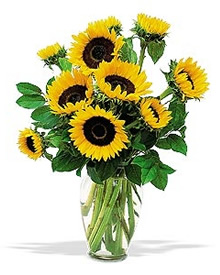With summer comes lots of plant life. All the leaves are green, and the flowers are blooming. If you’re a gardener, or want to display some great flowers in your home arrangements, here are some great ideas for you:
HIBISCUS
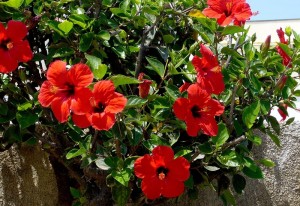 Giant red or pink flowers mark the garden containing the hibiscus plant. These plants can bloom from late spring until the first frost, and the stems of these perennials will die into the ground every year. The hibiscus genus of plants is large, containing hundreds of species, so you should have no problem matching a plant to your garden or home.
Giant red or pink flowers mark the garden containing the hibiscus plant. These plants can bloom from late spring until the first frost, and the stems of these perennials will die into the ground every year. The hibiscus genus of plants is large, containing hundreds of species, so you should have no problem matching a plant to your garden or home.
The hibiscus is the national flower of South Korea, Haiti, and Malaysia, as well as being the flower of Kali, the Hindu goddess. It is also a traditional flower worn by girls from Tahiti and Hawaii.
In a garden, hibiscus can be grown as landscape shrubs and will attract hummingbirds, butterflies and bees.
Indoors, the hibiscus can be grown in a container that is a slightly cosy fit. The plants can be moved to ideal locations, giving them some direct sunlight, ensuring they have excellent drainage to help grow the large blooms.
If you prune the plants while they are small, you will see more blooms as it matures within a few months.
ZINNIAS
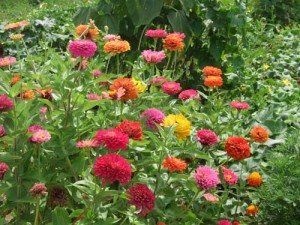 If you’re looking for something easy, and want to get loads of bouquets, the zinnia is for you. You can get more than enough for inside your home, and have lots left over to fill your garden or border your walking path for your house.
If you’re looking for something easy, and want to get loads of bouquets, the zinnia is for you. You can get more than enough for inside your home, and have lots left over to fill your garden or border your walking path for your house.
On top of providing a lot of blooms, these annuals can keep on blooming on into fall, giving your house a nice long supply of blooms, and keeping things looking fresh all summer. They can take 60 to 70 days to grow into a bloom from a seed, and will attract butterflies to your garden.
In order to get the most out of the zinnias you cut and bring into your house:
The best time to cut the flowers for your home is to wait for the dew to dry in the morning, and before the daytime heat dries and curls the petals or leaves
- Cut are the flowers that have just begun to open and are not fully blooming
- Stem should be 12” long from the bud and should be cut at a 45-degree angle
- Place the flowers in a bucket of cold water until you are ready to arrange them
- Heat water for a vase to 110 degrees Fahrenheit and put in a packet of preservative
- Remove leaves on the stem that will be below the water in the vase
- Cut off another ½ inch of stem at a 45-degree angle. This allows the stem to remain open and absorb moisture and nutrients
- Arrange the zinnias in the vase and keep it in a cool area with bright but indirect sunlight
- Replace the water every two days, or when it becomes cloudy, and remove zinnia stems when they begin to wilt
MARIGOLDS
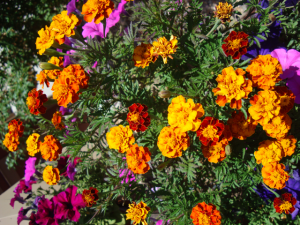 Marigolds are an easy flower to grow in your garden, and they can provide a long-lasting decoration inside your house when cut. The flower can provide bright blooms all summer long and into the fall. There are fifty species of marigolds and they have large variety and some provide excellent scents.
Marigolds are an easy flower to grow in your garden, and they can provide a long-lasting decoration inside your house when cut. The flower can provide bright blooms all summer long and into the fall. There are fifty species of marigolds and they have large variety and some provide excellent scents.
For flower arrangements featuring marigolds, remove leaves that will be under the water line in the vase. Doing this will prevent overly strong odours from the plant. Marigolds can also be dried for longer-lasting arrangements. To dry them properly:
- Trim the marigold in bloom during the morning after the dew has dried up. Cut the base of the stem below the level of the soil
- Tightly tie four to six stems together with an elastic band. The elastic needs to be tight since the stems will shrink as they dry
- Pick a spot to dry them that is warm with low humidity. You will want good circulation and no direct sunlight
- Hang the marigolds upside down from a hook using twine attached to the elastic
- Do not disturb or touch the flowers as they are drying
- After two to four weeks, the marigolds will dry completely. You can determine this by the shrunken stems and dry petals
- Take down the marigolds and use them in your arrangement
SUNFLOWERS
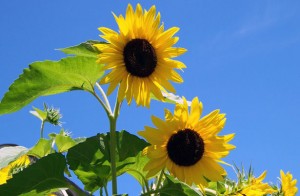 Who doesn’t like a sunflower? These flowers are instantly recognizable to anyone looking at a garden, and kids love them too. These tall annuals usually grow anywhere from 20” to a whopping 154”. And the bright yellow flower heads can make anyone smile.
Who doesn’t like a sunflower? These flowers are instantly recognizable to anyone looking at a garden, and kids love them too. These tall annuals usually grow anywhere from 20” to a whopping 154”. And the bright yellow flower heads can make anyone smile.
The best part about sunflowers is that they are easy to grow. You basically just stick a seed in the ground and watch it grow. Using sunflowers for indoor arrangements can bring excellent, bright colour to your home.
- Use a combination of one part bleach and ten parts water and rinse your shears in the solution then air dry
- Sunflowers should be cut as the petals begin to open, and before they completely unfurl.
- Cut the flowers in the morning after the dew has dried and before the warmer daytime temperatures
- Use a bucket of hot tap water to prevent wilting
- Leaving 24” of stem, cut a 45-degree angle and put the flowers in the bucket of water
- Put the bucket in a location that is cool with indirect sun for 24 hours. This will allow the stem to take in water
- Mix preservative with cool water in a vase
- Cut off another inch of stem while still in the water. Cut it at an angle, then place the flower into the vase
- Water should be replaced every one or two days to make the sunflower’s life as long as possible
There are lots of ways to enjoy the summer, and using your garden plants to create a summer-like atmosphere in your house can help bring some of the great weather indoors. Using some of the tips above, you can keep your flower arrangements looking fresh for a longer time, and get the most out of them.

